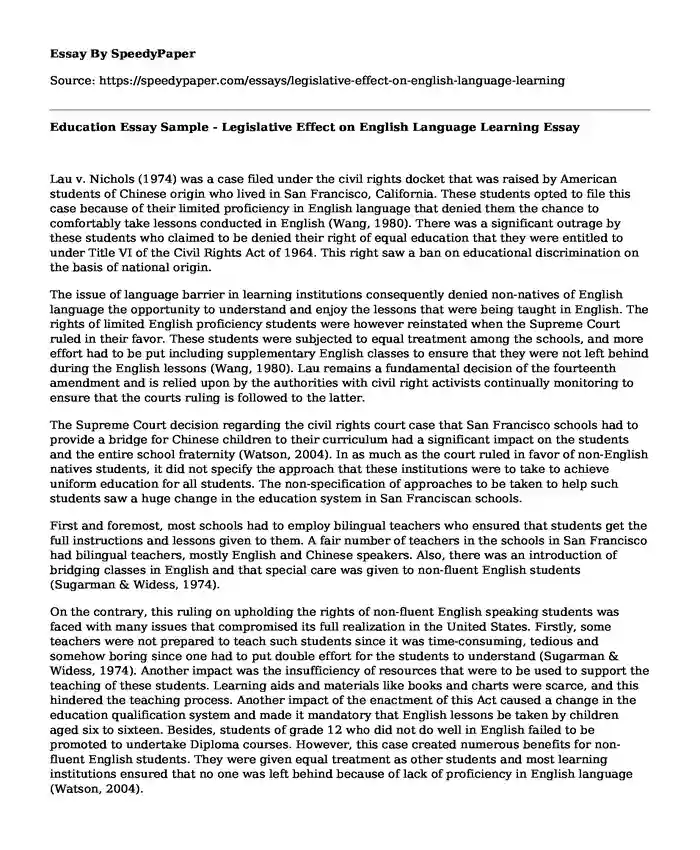Lau v. Nichols (1974) was a case filed under the civil rights docket that was raised by American students of Chinese origin who lived in San Francisco, California. These students opted to file this case because of their limited proficiency in English language that denied them the chance to comfortably take lessons conducted in English (Wang, 1980). There was a significant outrage by these students who claimed to be denied their right of equal education that they were entitled to under Title VI of the Civil Rights Act of 1964. This right saw a ban on educational discrimination on the basis of national origin.
The issue of language barrier in learning institutions consequently denied non-natives of English language the opportunity to understand and enjoy the lessons that were being taught in English. The rights of limited English proficiency students were however reinstated when the Supreme Court ruled in their favor. These students were subjected to equal treatment among the schools, and more effort had to be put including supplementary English classes to ensure that they were not left behind during the English lessons (Wang, 1980). Lau remains a fundamental decision of the fourteenth amendment and is relied upon by the authorities with civil right activists continually monitoring to ensure that the courts ruling is followed to the latter.
The Supreme Court decision regarding the civil rights court case that San Francisco schools had to provide a bridge for Chinese children to their curriculum had a significant impact on the students and the entire school fraternity (Watson, 2004). In as much as the court ruled in favor of non-English natives students, it did not specify the approach that these institutions were to take to achieve uniform education for all students. The non-specification of approaches to be taken to help such students saw a huge change in the education system in San Franciscan schools.
First and foremost, most schools had to employ bilingual teachers who ensured that students get the full instructions and lessons given to them. A fair number of teachers in the schools in San Francisco had bilingual teachers, mostly English and Chinese speakers. Also, there was an introduction of bridging classes in English and that special care was given to non-fluent English students (Sugarman & Widess, 1974).
On the contrary, this ruling on upholding the rights of non-fluent English speaking students was faced with many issues that compromised its full realization in the United States. Firstly, some teachers were not prepared to teach such students since it was time-consuming, tedious and somehow boring since one had to put double effort for the students to understand (Sugarman & Widess, 1974). Another impact was the insufficiency of resources that were to be used to support the teaching of these students. Learning aids and materials like books and charts were scarce, and this hindered the teaching process. Another impact of the enactment of this Act caused a change in the education qualification system and made it mandatory that English lessons be taken by children aged six to sixteen. Besides, students of grade 12 who did not do well in English failed to be promoted to undertake Diploma courses. However, this case created numerous benefits for non-fluent English students. They were given equal treatment as other students and most learning institutions ensured that no one was left behind because of lack of proficiency in English language (Watson, 2004).
In conclusion, Lau vs. Nichols case drove a significant impact on learning institutions in the United States. Students who were not fluent in English language were given special attention to ensure that they were not left behind as others progressed in education. Bridging courses in English were introduced, more bilingual teachers were introduced, and even learning materials were improved. However, this court ruling was faced with some challenges like some learning institutions did not practice it fully. Nevertheless, the non-fluent English students were given a fair consideration in most learning institutions of the United States.
References
Sugarman, S. D., & Widess, E. G. (1974). Equal protection for non-English-speaking school children: Lau v. Nichols. California Law Review, 157-182.
Wang, L. C. (1980). Lau v. Nichols: History of a struggle for equal and quality education. Asian-Americans: social and psychological perspectives, 2, 181-216.
Watson, T. S. (2004). Lau v. Nichols. Encyclopedia of School Psychology.
Cite this page
Education Essay Sample - Legislative Effect on English Language Learning. (2020, Apr 27). Retrieved from https://speedypaper.net/essays/legislative-effect-on-english-language-learning
Request Removal
If you are the original author of this essay and no longer wish to have it published on the SpeedyPaper website, please click below to request its removal:
- Computer Science Personal Statement Example
- Arguments for and Against the concept of Peak Oil. Free Essay on Energy.
- Free Essay: Breaking the Barriers and Comprehension for Middle Schools
- Should Drug Offenders Go to Prison? Get the Answer in the Free Essay
- Literary Essay Example: Theme of Resilience in A Thousand Splendid Suns
- Research Proposal Essay Sample: Uniform Policy Change
- Free Essay: Dual Admission Program
Popular categories





